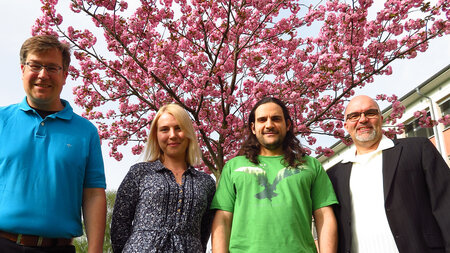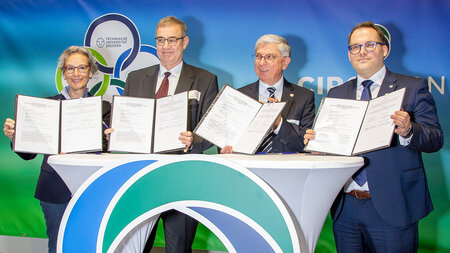Significant Increase in Third-Party Funding at Chemnitz University of Technology
Despite the Covid-19 pandemic, Chemnitz University of Technology was able to significantly increase its third-party funding income: from 70.3 million euros in 2020 to 78.7 million euros in 2021 - This means that in 2021, on average, a TUC professor raised more than half a million euros throughout the university
Chemnitz University of Technology has been extremely successful in attracting third-party funding in recent years. Its revenues increased by 15 percent during this period, from 68.6 million euros in 2019 to 70.3 million euros in 2020 to 78.7 million euros in 2021 - despite the Covid-19 pandemic. The largest share of third-party funding is attributable to federal funding. This is followed by funding from the German Research Foundation and funding from the European Union - which increased by around three and a half times from 1.5 million euros in 2020 to 5.1 million euros in 2021. Funding from industry has also increased by about a quarter, from €6.1 million in 2020 to €7.6 million in 2021, despite the anticipated impact of the Covid-19 pandemic in this area in particular.
In 2021, Chemnitz University of Technology received an average of 535,512 euros in third-party funding per professorship. Consequently, a TUC professor acquired an average of more than half a million euros across the university in 2021.
The settlement of the target agreement with the Saxon Ministry of Science 2017-2020 already showed that Chemnitz University of Technology not only achieved the target value in the area of third-party funding from competitive, science-led procedures (from 14 million euros on average for the years 2017-2020) with 55.8 million euros on average for the years 2017-2020, but significantly exceeded it by a factor of around four.
"I would like to express my sincere thanks to all colleagues at Chemnitz University of Technology who have contributed to this extremely impressive development of our third-party funding income. It is by no means only the quantity of third-party funds that is impressive, but also the outstanding quality of various projects financed by these funds or the associated qualification work of young scientists and transfer services to industry," says Prof. Dr. Gerd Strohmeier, President of Chemnitz University of Technology.
Collaborative research center focuses on interaction between man and machine
The Collaborative Research Center (SFB) Hybrid Societies established by the German Research Foundation (DFG) at Chemnitz University of Technology, which will receive funding of 9.5 million euros over the first four years, has made a significant contribution to the successful third-party funding balance in recent years. All eight faculties of Chemnitz University of Technology are involved in this "lighthouse project" of the university, which started on January 1, 2020. The focus of the SFB is in particular on researching the question of how the interaction between humans and machines can be designed effectively. 30 professors and senior researchers at the university are fundamentally investigating, for example, how autonomous vehicles move in public spaces or how robots can coordinate with humans. A research training group is also integrated into this SFB.
Tailored properties for novel materials in electronics
One of the most recent examples from the successful acquisition of third-party funding at the DFG is the new research group "Proximity-induced correlation effects in low-dimensional systems", which was established at the end of 2021 under the leadership of Chemnitz University of Technology. This research group will be funded with approximately 3.2 million euros plus a 22 percent program allowance for indirect costs in the first four-year funding period. Future research will focus on atomically thin carbon films such as graphene, which is often referred to as the "wonder drug of the future" due to its outstanding electrical, mechanical and optical properties. With its investigations, the interdisciplinary research group aims to create further foundations for novel quantum materials with tailored properties and their application, for example in electronics or spintronics.
Million-euro funding for two WIR! projects helps structural change in the Erzgebirge region
In the area of federal funding, the two collaborative projects Smart Rail Connectivity-Campus (SRCC) and Smart Composites ERZgebirge (SmartERZ), in which Chemnitz University of Technology is significantly involved as part of the program WIR! - Change through Innovation in the Region of the Federal Ministry of Education and Research (BMBF), stand out in particular since 2019. Since April 1, 2019, up to around 30 million euros have been available to the two WIR! joint projects in the five-year implementation phase. With the overall SRCC project, Chemnitz University of Technology and the city of Annaberg-Buchholz want to establish a globally visible center for research, development and testing in the innovation field of intelligent rail transport (Smart Rail) at the Annaberg-Buchholz site. Research and development work on digitized, networked, automated and sustainable mobility will be implemented at this center. SmartERZ encompasses the dynamic growth market of function-integrated composites or smart composites. These are textile-reinforced plastics into which functional structures, i.e. sensors, actuators and electronic components, are integrated. In this way, passive textiles in combination with plastics become intelligent semi-finished products that are used, for example, in the automotive and aerospace sectors, in medical technology and in the construction industry. Chemnitz University of Technology contributes the expertise of several professorships to these two alliances, which are very strongly linked to the Erzgebirge region and are intended to contribute to structural change there.
Background: Third-party funds
According to the Federal Statistical Office, third-party funds are funds raised by universities from public or private sources in addition to the regular university budget (basic funding) to promote research and development as well as young scientists and teaching. Third-party funding comes from the German Research Foundation, federal ministries, the European Union, foundations and industry, among others.
(Translation: Brent Benofsky)
Matthias Fejes
19.09.2022






